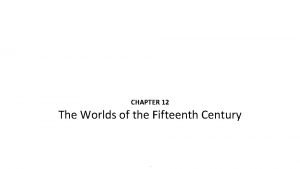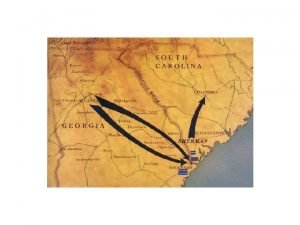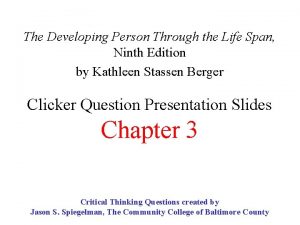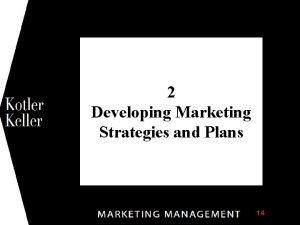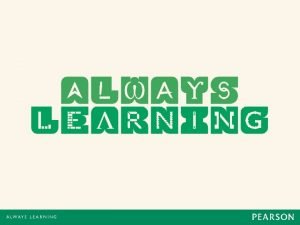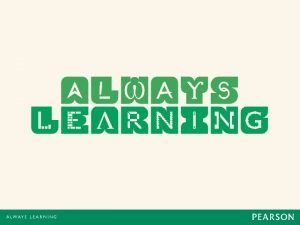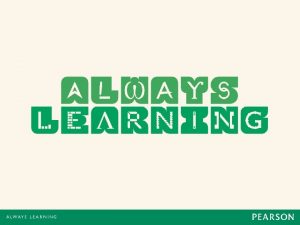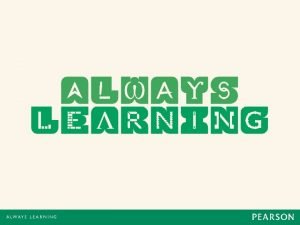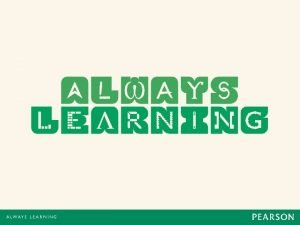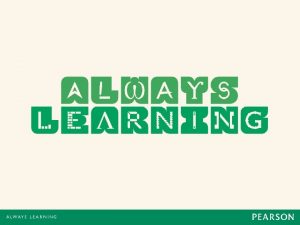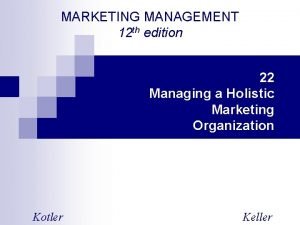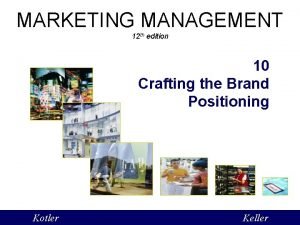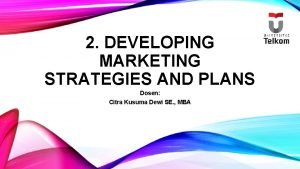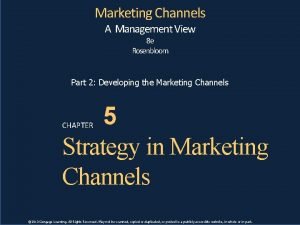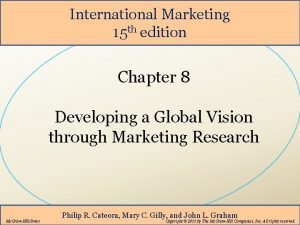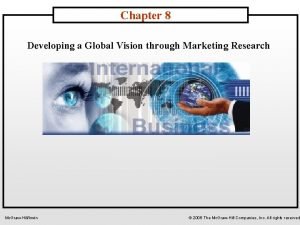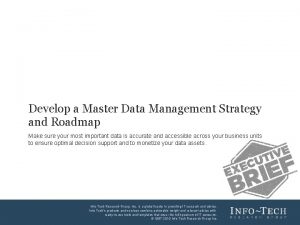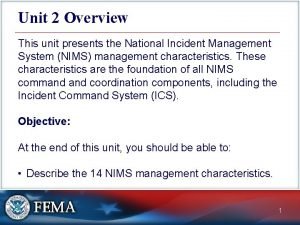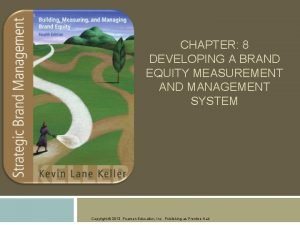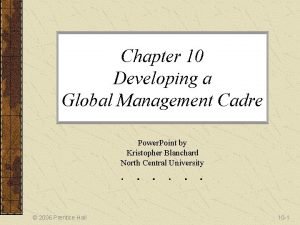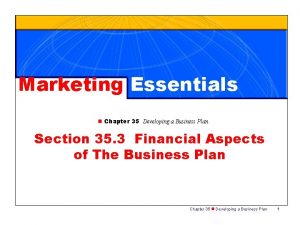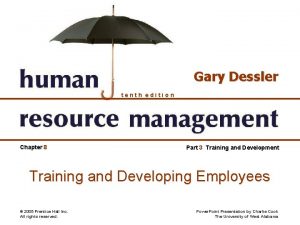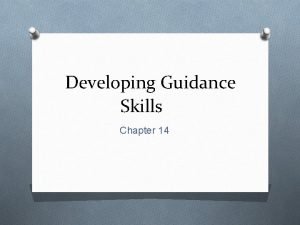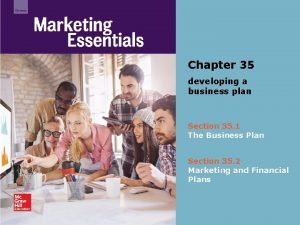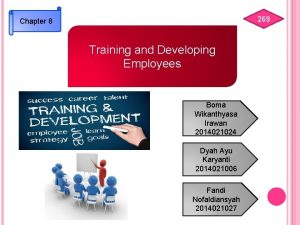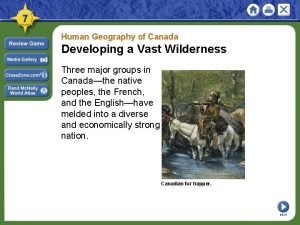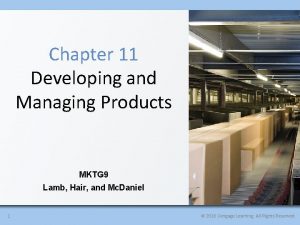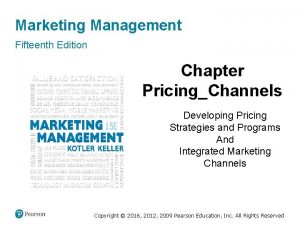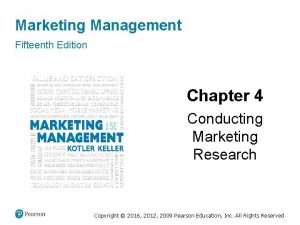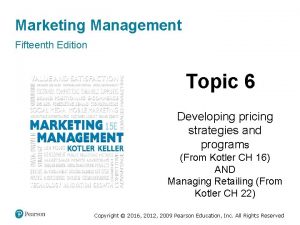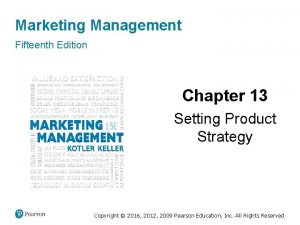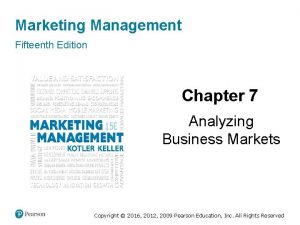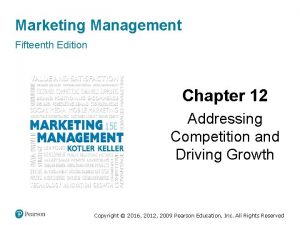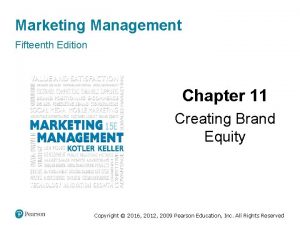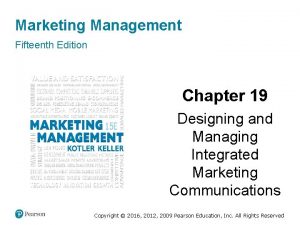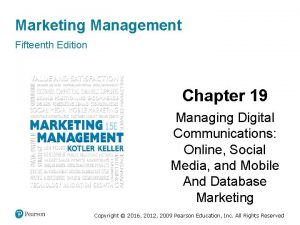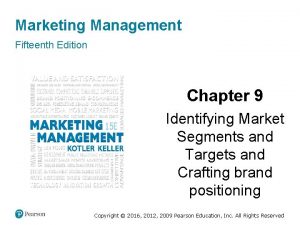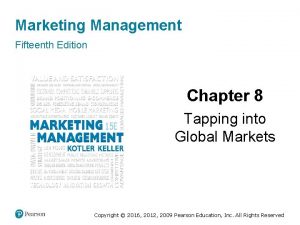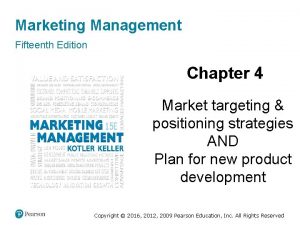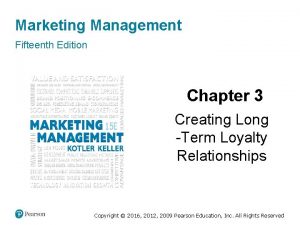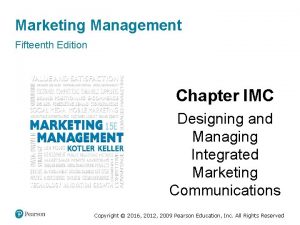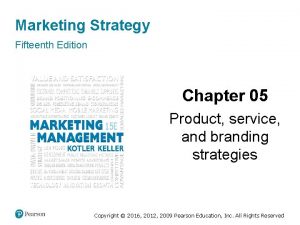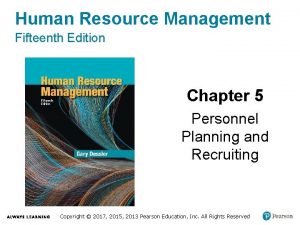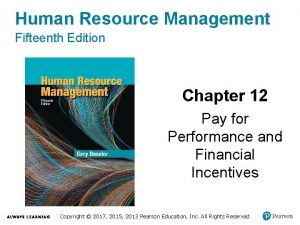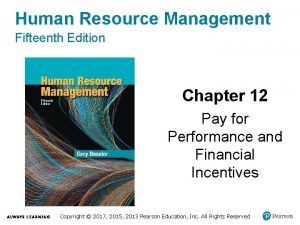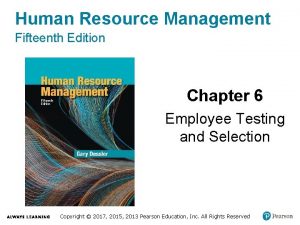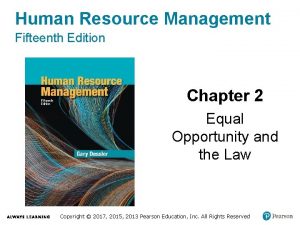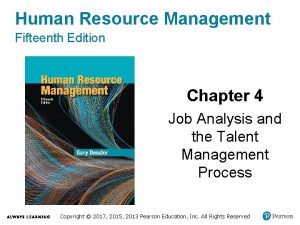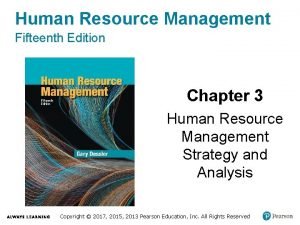Marketing Management Fifteenth Edition Chapter 2 Developing Marketing












































- Slides: 44

Marketing Management Fifteenth Edition Chapter 2 Developing Marketing Strategies and Plans Copyright © 2016, 2012, 2009 Pearson Education, Inc. All Rights Reserved

Learning Objectives 2. 1 How does marketing affect customer value? 2. 2 How is strategic planning carried out at the corporate and divisional levels? 2. 3 How is strategic planning carried out at the business unit level? 2. 4 What does a marketing plan include? Copyright © 2016, 2012, 2009 Pearson Education, Inc. All Rights Reserved

Kotler on Marketing It’s more important to do what is strategically correct than what is immediately profitable. Copyright © 2016, 2012, 2009 Pearson Education, Inc. All Rights Reserved

Bashir on Marketing It’s rather more important to do what is ethically correct than what is just strategic to the marketer. Copyright © 2016, 2012, 2009 Pearson Education, Inc. All Rights Reserved

Marketing and Customer Value • The value delivery process • The value chain • Core competencies • The central role of strategic planning Copyright © 2016, 2012, 2009 Pearson Education, Inc. All Rights Reserved

The Value Delivery Process • Choosing the value • Providing the value • Communicating the value Copyright © 2016, 2012, 2009 Pearson Education, Inc. All Rights Reserved

The Value Chain • A tool for identifying ways to create more customer value – Every firm is a synthesis of activities performed to design, produce, market, deliver, and support its product Copyright © 2016, 2012, 2009 Pearson Education, Inc. All Rights Reserved

Value chain • Primary activities: 1. Inbound logistics 2. Operations 3. Outbound logistics 4. Marketing 5. Service • Support activities: 1. Procurement 2. Technology development 3. Human resource management 4. Firm infrastructure Copyright © 2016, 2012, 2009 Pearson Education, Inc. All Rights Reserved

Core Competencies • A source of competitive advantage and makes a significant contribution to perceived customer benefits • Applications in a wide variety of markets • Difficult for competitors to imitate Copyright © 2016, 2012, 2009 Pearson Education, Inc. All Rights Reserved

Maximizing Core Competencies Businesses need to realign themselves to maximize core competencies. Realignment has three steps: • (Re)define the business concept • (Re)shaping the business scope • (Re)positioning the company’s brand identity Copyright © 2016, 2012, 2009 Pearson Education, Inc. All Rights Reserved

Central Role of Strategic Planning • Managing the businesses as an investment portfolio • Assessing the market’s growth rate and the company’s position in that market • Establishing a strategy Copyright © 2016, 2012, 2009 Pearson Education, Inc. All Rights Reserved

Marketing Plan • The central instrument for directing and coordinating the marketing effort – Strategic – Tactical Copyright © 2016, 2012, 2009 Pearson Education, Inc. All Rights Reserved

Figure 2. 1 Strategic Planning, Implementation, and Control Processes Copyright © 2016, 2012, 2009 Pearson Education, Inc. All Rights Reserved

Corporate and Division Strategic Planning • Defining the corporate mission • Establishing strategic business units • Assigning resources to each strategic business unit • Assessing growth opportunities Copyright © 2016, 2012, 2009 Pearson Education, Inc. All Rights Reserved

Defining the Corporate Mission • What is our business? • Who is the customer? • What is of value to the customer? • What will our business be? • What should our business be? Copyright © 2016, 2012, 2009 Pearson Education, Inc. All Rights Reserved

Product Orientation vs. Market Orientation Company Product Market Missouri-Pacific Railroad We run a railroad We are a peopleand-goods mover Xerox We make copying We improve office equipment productivity Standard Oil We sell gasoline Columbia Pictures We make movies We supply energy We market entertainment Copyright © 2016, 2012, 2009 Pearson Education, Inc. All Rights Reserved

Good Mission Statements • Focus on a limited number of goals • Stress the company’s major policies and values • Define the major competitive spheres within which the company will operate • Take a long-term view • Are as short, memorable, and meaningful as possible Copyright © 2016, 2012, 2009 Pearson Education, Inc. All Rights Reserved

Mission statement • To build total brand value by innovating to deliver customer value and customer leadership faster, better, and more completely than our competition. (vague mission statement) • Google’s “To organize the world’s information and make it universally accessible and useful. ” (Good mission statement) Copyright © 2016, 2012, 2009 Pearson Education, Inc. All Rights Reserved

Establishing Strategic Business Units • A single business or collection of related businesses • Has its own set of competitors • Has a leader responsible for strategic planning and profitability Copyright © 2016, 2012, 2009 Pearson Education, Inc. All Rights Reserved

Assigning Resources to Each SBU • Management must decide how to allocate corporate resources to each SBU – Portfolio-planning models – Shareholder/market value analysis Copyright © 2016, 2012, 2009 Pearson Education, Inc. All Rights Reserved

Assessing Growth Opportunities (1 of 2) Figure 2. 2 The Strategic- Planning Gap Copyright © 2016, 2012, 2009 Pearson Education, Inc. All Rights Reserved

Assessing Growth Opportunities (2 of 2) • Intensive Growth • Integrative Growth • Diversification Growth • Downsizing and Divesting Older Businesses Copyright © 2016, 2012, 2009 Pearson Education, Inc. All Rights Reserved

Intensive Growth • Corporate management should first review opportunities for improving existing businesses Copyright © 2016, 2012, 2009 Pearson Education, Inc. All Rights Reserved

Integrative Growth • A business can increase sales and profits through backward, forward, or horizontal integration within its industry Copyright © 2016, 2012, 2009 Pearson Education, Inc. All Rights Reserved

Diversification Growth • Diversification growth makes sense when good opportunities exist outside the present businesses – The industry is highly attractive and the company has the right mix of business strengths to succeed Copyright © 2016, 2012, 2009 Pearson Education, Inc. All Rights Reserved

Downsizing and Divesting Older Businesses • Companies must carefully prune, harvest, or divest tired old businesses to release needed resources for other uses and reduce costs Copyright © 2016, 2012, 2009 Pearson Education, Inc. All Rights Reserved

Organization and Organizational Culture (1 of 2) • A company’s organization consists of its structures, policies, and corporate culture, all of which can become dysfunctional in a rapidly changing business environment Copyright © 2016, 2012, 2009 Pearson Education, Inc. All Rights Reserved

Organization and Organizational Culture (2 of 2) • Corporate culture: “The shared experiences, stories, beliefs, and norms that characterize an organization” Copyright © 2016, 2012, 2009 Pearson Education, Inc. All Rights Reserved

Figure 2. 4 The Business Unit Strategic-Planning Process Copyright © 2016, 2012, 2009 Pearson Education, Inc. All Rights Reserved

30 Micro Environment Forces • Company environment • Suppliers • Marketing Intermediaries • Customers • Competitors • Public Copyright © 2016, 2012, 2009 Pearson Education, Inc. All Rights Reserved

31 Macro Environment Forces • Demographic Forces • Economic Forces • Natural Forces • Technological Forces • Political Forces • Cultural Forces Copyright © 2016, 2012, 2009 Pearson Education, Inc. All Rights Reserved

SWOT Analysis • Strengths • Weaknesses • Opportunities • Threats Copyright © 2016, 2012, 2009 Pearson Education, Inc. All Rights Reserved

Checklist for evaluating strengths/weakness analysis Copyright © 2016, 2012, 2009 Pearson Education, Inc. All Rights Reserved

Figure 2. 5 Opportunity And Threat Matrices Copyright © 2016, 2012, 2009 Pearson Education, Inc. All Rights Reserved

TOWS Matrix Copyright © 2016, 2012, 2009 Pearson Education, Inc. All Rights Reserved

Goal Formulation (MBO) • Unit’s objectives must be arranged hierarchically • Objectives should be quantitative • Goals should be realistic • Objectives must be consistent Copyright © 2016, 2012, 2009 Pearson Education, Inc. All Rights Reserved

Strategic Formulation: Porter’s Generic Strategies • Overall cost leadership • Differentiation • Focus Copyright © 2016, 2012, 2009 Pearson Education, Inc. All Rights Reserved

Strategic Formulation: Strategic Alliances • Categories of marketing alliances – – Product or service alliance (City Bank with AMEX) Promotional alliance (Coca Cola and Mc. Donald’s) Logistics alliances Pricing collaborations (Hotel and car rental service) Copyright © 2016, 2012, 2009 Pearson Education, Inc. All Rights Reserved

Program Formulation and Implementation • Mc. Kinsey’s Elements of Success – – – – Skills Staff Style Strategy Structure Systems Shared values Copyright © 2016, 2012, 2009 Pearson Education, Inc. All Rights Reserved

Feedback and Control • Peter Drucker: it is more important to “do the right thing”—to be effective—than “to do things right”—to be efficient – The most successful companies, however, excel at both Copyright © 2016, 2012, 2009 Pearson Education, Inc. All Rights Reserved

Marketing Plan Contents • Executive summary • Table of contents • Situation analysis • Marketing strategy • Marketing tactics • Financial projections • Implementation controls Copyright © 2016, 2012, 2009 Pearson Education, Inc. All Rights Reserved

Evaluating a Marketing Plan • Is the plan simple/succinct? • Is the plan complete? • Is the plan specific? • Is the plan realistic? Copyright © 2016, 2012, 2009 Pearson Education, Inc. All Rights Reserved

Other Marketing Plan Contents • Marketing research • Specifications for internal and external relationships • Action plans and schedules Copyright © 2016, 2012, 2009 Pearson Education, Inc. All Rights Reserved

Copyright © 2016, 2012, 2009 Pearson Education, Inc. All Rights Reserved
 Human resource management fifteenth edition
Human resource management fifteenth edition Management fifteenth edition
Management fifteenth edition University physics with modern physics fifteenth edition
University physics with modern physics fifteenth edition Chapter 12 the worlds of the fifteenth century
Chapter 12 the worlds of the fifteenth century The worlds of the fifteenth century
The worlds of the fifteenth century Dessert in french classical menu means
Dessert in french classical menu means Fifteenth amendment
Fifteenth amendment The developing person through the life span 9th edition
The developing person through the life span 9th edition The developing person through the life span 9th edition
The developing person through the life span 9th edition The developing person through the life span 9th edition
The developing person through the life span 9th edition The developing person through childhood 7th edition
The developing person through childhood 7th edition Example of fast mapping
Example of fast mapping The marketing plan the central instrument
The marketing plan the central instrument The marketing plan the central instrument
The marketing plan the central instrument Marketing management (arab world edition)
Marketing management (arab world edition) Marketing management (arab world edition) philip kotler
Marketing management (arab world edition) philip kotler Marketing management (arab world edition) philip kotler
Marketing management (arab world edition) philip kotler Marketing management (arab world edition) philip kotler
Marketing management (arab world edition) philip kotler Kotler e keller
Kotler e keller Marketing management (arab world edition)
Marketing management (arab world edition) Marketing management 12th edition
Marketing management 12th edition Marketing management 12th edition
Marketing management 12th edition Using mis 10th edition
Using mis 10th edition Using mis (10th edition) 10th edition
Using mis (10th edition) 10th edition Principle of management by stephen p robbins
Principle of management by stephen p robbins Global vision marketing definition
Global vision marketing definition Materi developing marketing strategies and plans
Materi developing marketing strategies and plans Developing the marketing channel
Developing the marketing channel Breadth and scope of international marketing research
Breadth and scope of international marketing research Developing a global vision through marketing research
Developing a global vision through marketing research Global vision marketing definition
Global vision marketing definition Data management strategy roadmap
Data management strategy roadmap Which nims management characteristics includes developing
Which nims management characteristics includes developing Brand equity responsibilities
Brand equity responsibilities Developing a global management cadre
Developing a global management cadre Chapter 35 developing a business plan
Chapter 35 developing a business plan Chapter 8 training and developing employees
Chapter 8 training and developing employees Chapter 15 developing fraction concepts
Chapter 15 developing fraction concepts Developing guidance skills chapter 14
Developing guidance skills chapter 14 Chapter 35 developing a business plan
Chapter 35 developing a business plan Chapter 17:1 developing job-keeping skills
Chapter 17:1 developing job-keeping skills Chapter 8 training and developing employees
Chapter 8 training and developing employees Chapter 3 lesson 2 health
Chapter 3 lesson 2 health Chapter 7 developing a vast wilderness
Chapter 7 developing a vast wilderness Chapter 11 developing and managing products
Chapter 11 developing and managing products




